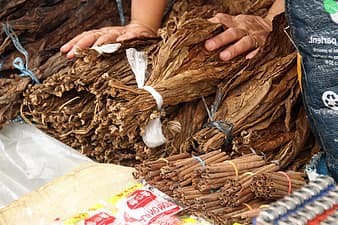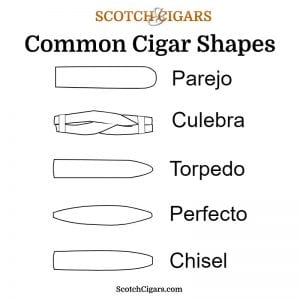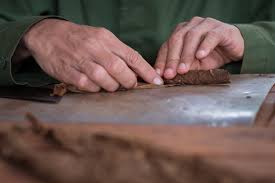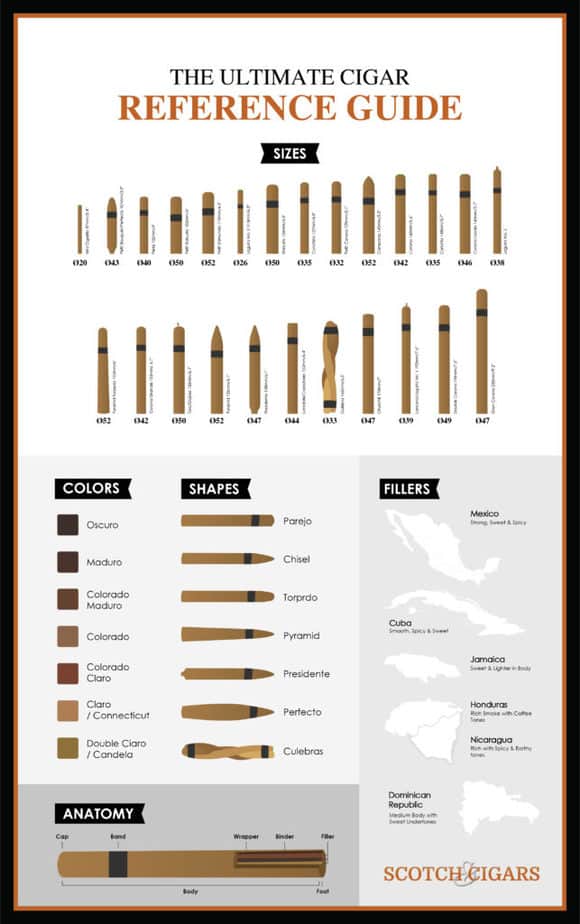A gentleman’s guide to understanding the basics of cigars, so you’ll have the confidence to talk about and purchase cigars.
Suggested Guides
- How to smoke a cigar
- How to cut a cigar
- How to light a cigar
- Traveling with cigars on airplanes
- How to store cigars in a humidor
- How cigars are rated
- Are cigar lounges legal?
- Getting rid of cigar breath
- How to hold a cigar in your mouth
- How to get rid of cigar smell
- Do cigars give you a buzz?
- Tips for smoking in a car
- 5 Facts about cigar tubos
- How cigar tobacco is cured
Cigar Wrappers
The wrapper is one of the most important parts of a cigar. It has a significant impact on the overall taste of a cigar and adds its scent.
Two of the most popular wrappers are Connecticut and maduro. My personal favorite cigar, Macanudo Cafe, uses a Connecticut wrapper. The Connecticut wrapper is actually a specific type of claro wrapper. So, while there are many different wrappers, for the most part they fall under six different types.
- Double Claro
- Claro
- Colorado Claro
- Colorado
- Colorado Marudro
- Maduro
Double Claro is easily recognizable by its green color. It’s also know as American Market Selection or Candela.
Claro has a light tan/beige color and is typically from Connecticut.
Colorado Claro is medium brown and found on many cigars.
Colorado wrappers have a reddish tint.
Colorado Maduro are darker than Colorado wrappers. These wrappers are typically associated with African tobacco, such as from Cameroon, but also from Havana seed tobacco grown in Honduras.
Maduro is very dark brown or even black in color. In my opinion, cigars with maduro wrappers are not for beginners. Beginners may feel sick the first time they smoke a cigar with a maduro wrapper.
Cigar wrappers are prone to cracking if they aren’t properly stored. Here are reasons why your cigar wrapper cracks, how to avoid cracking, and how to repair cracked cigars.
Cigar Tobacco

Cigar tobaccos takes about 18 months to grow, but the overall process from seed to cigar takes about 2 years.
There are basically two types of filler in the cigar. One of them is a low-end filler and the other is a high-end filler.
Low-end filler is made from bits of tobacco leaves that are stuffed together. These pieces are essentially leftovers from pieces broken off leaves used in high-end cigars or lower quality leaves.
High-end cigars use long leaves to fill the cigars. They typically run the entire length of the cigar. Different cigar flavors can be made by using different quantities and combinations of different tobacco leaves. Each combination creates a unique flavor that a discerning aficionado would appreciate.
Tobacco for cigars is grown in many different countries, and as a result, there are many countries that make cigars. The most well-known countries for producing cigars are Cuba and the Dominican Republic.
Cigar Sizes
The size of a cigar is measured according to its length (in inches) and its diameter (according to its ring gauge).
For example, a cigard can have the measurements 7×48, which means it is 7 inches long and has a ring size of 48, which translates to 3/4 inch.
Cigar Ring Gauge (Ring Size)
The diameter (thickness) of cigars is measured using ring gauges. You have probably seen the numbers before and were able to figure out that the bigger the number, the bigger the diameter. Yes, it is opposite of sheet metal, where smaller gauge means thicker metal.
The numerical ring system actually has a meaning. Each number tells you how many 64ths of an inch the diameter is.
For example, a 64 ring gauge is 64/64, so it’s one inch diameter. Also, a 32 ring gauge is 32/64, so it’s half an inch thick, and a 48 ring gauge is 48/64, so it’s 3/4 inch thick.
Shape of Cigars
Most people choose cigars based on how they look. You can’t blame them; we all associated different cigars with different people in history, different personalities, and different celebrities.
For example, I picture a four star general smoking a churchill, an actor from the 20s with a slick suit, perfectly combed hair and clean-shaven face to smoke a corona or a petite corona.
However, the shape of a cigar affects how it smokes and, believe it or not, how it tastes.
Parts of a Cigar
There are 4 main parts to a cigar:
- Cap (Tip) – This is the part that gets cut
- Head – This is the part that you put in your mouth
- Foot – The side of the cigar that gets lit
- Body – The body is in between the foot and the head
Then there are 3 main components that make up a cigar:
- Wrapper
- Binder
- Filler
Shapes of a Cigar
There are many specific shapes of cigars, but they fall into two different categories: Parejos (straight barrel) and Figurados (any shape that isn’t a barrel).

Parejos (Straight Barrel)
- Churchill: (7×48)
- Corona: (5.5×42) – (6×44)
- Double Corona: (7.5×49) – (8×52)
- Lonsdale: (6.25×42) – (7×44)
- Panatela: (5×38) – (6×38)
- Petite Corona: (4.5×40) – (4.5×42)
- Robusto: (4.5×50) – (5.5×50)
- Toro, Corona, Gordo: (5×46) – (6×50)
Figurados
- Culebra: 3 panatelas twisted together
- Pyramid: (6×40) – (7×54) (sharply tapered head and larger foot)
- Torpedo: (6×40) – (7×54) (closed foot and a pointed head)
- Belicoso: (5×50) – (5.5×50) (tapered head)
- Perfecto: (4.5×38) – (9×48) (closed foot, a round head, and a bulge in the middle)
.
Choosing the Right Cigar
There are so many combinations of choices when looking for the right cigar: length, ring gauge, tobacco origin, wrapper.
In the end, there is no “right” cigar for everyone. It’s up to you to try and find the one you like the most. as with most people, your taste will evolve with time, so the right cigar for you now may be completely different than the right cigar for you a few years from now.
Before you invest in a box of cigars, you should try a bunch and see what you like the most. You could even take some notes about them and see if there’s a trend in what you liked and didn’t like, so you can find the right one. For example, you might find that you don’t like Connecticut wrappers, and you don’t like torpedo-shaped cigars.
If you’re looking to get started, we put together a list of the top 10 cigars for beginners to help you out. As we said, there’s no way we will know which one you like the best, but from experience we can suggest the best ones to start with.
Joining a monthly sample club is the best option for novice cigar smokers. You’ll gain a lot of knowledge. Most clubs send along information about the cigars with the cigars, plus you’ll get to enjoy all different types of cigars.
Why So Expensive?
Hand-rolled vs. Factory Made

It costs more to make a great cigar. The best cigars are all hand rolled. Cigars made in factories can be sold for less because they are mass-produced.


